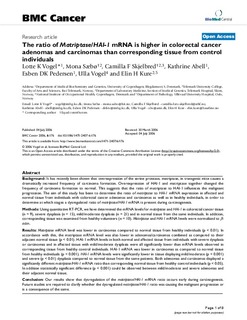The ratio of Matriptase/HAI-1 mRNA is higher in colorectal cancer adenomas and carcinomas than corresponding tissue from control individuals
Vogel, Lotte K.; Sæbø, Mona; Skjelbred, Camilla Furu; Abell, Kathrine; Pedersen, Esben D.K.; Vogel, Ulla; Kure, Elin H.
Journal article, Peer reviewed
Published version
Permanent lenke
http://hdl.handle.net/11250/2437983Utgivelsesdato
2006-07-04Metadata
Vis full innførselSamlinger
Sammendrag
BACKGROUND: It has recently been shown that overexpression of the serine protease, matriptase, in transgenic mice causes a dramatically increased frequency of carcinoma formation. Overexpression of HAI-1 and matriptase together changed the frequency of carcinoma formation to normal. This suggests that the ratio of matriptase to HAI-1 influences the malignant progression. The aim of this study has been to determine the ratio of matriptase to HAI-1 mRNA expression in affected and normal tissue from individuals with colorectal cancer adenomas and carcinomas as well as in healthy individuals, in order to determine at which stages a dysregulated ratio of matriptase/HAI-1 mRNA is present during carcinogenesis. METHODS: Using quantitative RT-PCR, we have determined the mRNA levels for matriptase and HAI-1 in colorectal cancer tissue (n = 9), severe dysplasia (n = 15), mild/moderate dysplasia (n = 21) and in normal tissue from the same individuals. In addition, corresponding tissue was examined from healthy volunteers (n = 10). Matriptase and HAI-1 mRNA levels were normalized to beta-actin. RESULTS: Matriptase mRNA level was lower in carcinomas compared to normal tissue from healthy individuals (p < 0.01). In accordance with this, the matriptase mRNA level was also lower in adenomas/carcinomas combined as compared to their adjacent normal tissue (p < 0.01). HAI-1 mRNA levels in both normal and affected tissue from individuals with severe dysplasia or carcinomas and in affected tissue with mild/moderate dysplasia were all significantly lower than mRNA levels observed in corresponding tissue from healthy control individuals. HAI-1 mRNA was lower in carcinomas as compared to normal tissue from healthy individuals (p < 0.001). HAI-1 mRNA levels were significantly lower in tissue displaying mild/moderate (p < 0.001) and severe (p < 0.01) dysplasia compared to normal tissue from the same patients. Both adenomas and carcinomas displayed a significantly different matriptase/HAI-1 mRNA ratio than corresponding normal tissue from healthy control individuals (p < 0.05). In addition statistically significant difference (p < 0.001) could be observed between mild/moderate and severe adenomas and their adjacent normal tissue. CONCLUSION: Our results show that dysregulation of the matriptase/HAI-1 mRNA ratio occurs early during carcinogenesis. Future studies are required to clarify whether the dysregulated matriptase/HAI-1 ratio was causing the malignant progression or is a consequence of the same. Dyreeksperimenter har vist at matripase (en serine protease) øker risikoen for kreftutvikling mens hepatocyte growth factor activator inhibitor (HAI-1) normaliserte risikoen. I denne delstudier har en derfor sett på ratio matripase/HAI-1 i vev fra adenomer og cancer og normalslimhinne fra de samme pasientene. Både adenomer og cancer viste et signifikant forskjellig ratio enn normalsimhinne. Dette kan tyde på at en dysregulating av dette ratio kan opptre tidlig i carcinogeneseprosessen, men studien kan ikke avdekke om dette er en årsak til eller en følge av malignitetsutviklingen.
